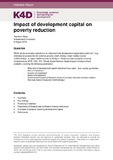| dc.contributor.author | Salam, Tasneem | |
| dc.date.accessioned | 2019-10-08T09:23:04Z | |
| dc.date.available | 2019-10-08T09:23:04Z | |
| dc.date.issued | 2019-08-08 | |
| dc.identifier.citation | Salam, T. (2019). Impact of development capital on poverty reduction. K4D Helpdesk Report. Brighton, UK: Institute of Development Studies. | en |
| dc.identifier.uri | https://opendocs.ids.ac.uk/opendocs/handle/20.500.12413/14735 | |
| dc.description.abstract | Evidence from current publicly available literature indicates that development capital has a positive impact on poverty reduction, but that this is achieved through indirect and induced impact rather than through direct impact. International Finance Corporation’s (IFC) response to an Independent Evaluation Group evaluation is that “IFC engagements are focused on private sector development, job creation and sustainability and are therefore a means to an end to reduce poverty”. Whilst there is quite a lot that has been written about the effectiveness of development capital in improving the lives of people in poverty, none of the literature addresses directly the three different levels of poverty set out in the query.1 It is perhaps timely for development community to commission or carry out itself a rigorous study of impact of development capital on the three levels of poverty, firstly defining a methodology that could do this effectively. The literature indicates that to date development capital has been more effective in lower middle-income or upper middle-income poverty but is also supportive to reducing extreme income poverty. A part of the reason for this bias is that development capital is not focused on the poorest populations and tends to be directed at middle-income countries. There are examples of development capital that has been effective in reducing extreme poverty when it has been directed at the poorest. For the most part, however, development capital’s impact on extreme poverty occurs in an indirect way, for example, when development capital recipients have clients who are from the poorest sections of the population. The link from growth to poverty reduction is, however, not automatic, and deliberate action is often required to incorporate distributional aspects of growth into project design and implementation. A key recommendation from the literature is the need to develop creative products and approaches to facilitate private investment in frontier markets. At the same time, innovative financing needs to be rooted in the overall objective of poverty reduction. It should be noted that where evaluation of programmes do exist, there is negligible information on gender and inclusion in general. Both institution level and project level evaluation exists, but much of this is in-house. There is limited independent review of impact. | en |
| dc.language.iso | en | en |
| dc.publisher | IDS | en |
| dc.relation.ispartofseries | K4D Helpdesk Report;568 | |
| dc.rights.uri | https://www.nationalarchives.gov.uk/doc/open-government-licence/version/3/ | en |
| dc.subject | Development Policy | en |
| dc.subject | Economic Development | en |
| dc.subject | Poverty | en |
| dc.title | Impact of Development Capital on Poverty Reduction | en |
| dc.type | Helpdesk | en |
| dc.rights.holder | © DFID - Crown copyright 2019 | en |
| dcterms.dateAccepted | 2019-08-08 | |
| rioxxterms.funder | Department for International Development, UK Government | en |
| rioxxterms.identifier.project | K4D | en |
| rioxxterms.version | VoR | en |
| rioxxterms.funder.project | 238a9fa4-fe4a-4380-996b-995f33607ba0 | en |

